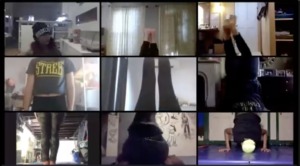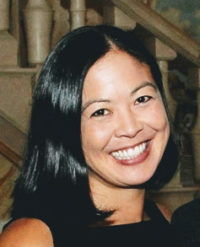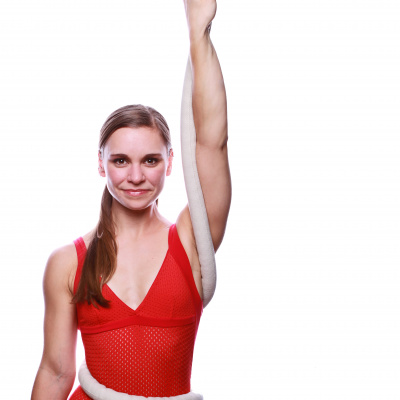How STREB’s Action Heroes Navigate the Zoom Conundrum
The question that comes to mind is, how have you been surviving? This is not a hyperbole as the world literally negotiates a deadly virus. It is not a distortion when business and organizations are permanently closing. This article chronicles how Brooklyn-based STREB EXTREME ACTION company has survived the past few months. The company members are literally called Action Heroes. Who better to give some insight as to how to survive?
To get a full sense of how the company has transitioned to the remote and virtual, I interviewed Elizabeth Streb (Founder and Artistic Director), Christine Chen (Executive Director) and Cassandre Joseph (Associate Artistic Director). The conversations proved that the company’s trademark tenacity, curiosity and care for each other and their community has not diluted as they rehearse, perform and teach via Zoom.
The company has gained world fame for Streb’s unique philosophies about the body, space, time and force. “I invent things: equipment and actions,” Streb says. “But I really pose questions more than I tell them [the company] what to do. The questions are inherent in the equipment. We have a piece of equipment manipulate you, or you enter its force field in a way to cause things to happen that must happen. It’s a discovery process. I always think of myself as an explorer.” Underlying the exploration is Streb’s physical technique called PopAction.
STREB has performed at two Olympics and bounced from Greece to Chile, Canada to Taiwan, Australia to France. This kind of global attention might suggest an air of aloof grandeur. This couldn’t be farther from the truth. The Streb Lab for Action Mechanics (SLAM), the company’s home base, is a Brooklyn warehouse. Primary colors splash the walls and every inch is dedicated to supporting the company’s artistic mission and community engagement. Like the physical technique, nothing is superfluous. Personally, I have had the pleasure of participating in the in SLAM community as a student, a performer, a renter and a producer. It is a space that fosters possibility, not elitism. If grandeur exists, it is in the company’s authentic commitment to the work at hand.
I asked to start at the beginning. “What were the first steps the company took to go remote?”
“It’s a little hazy,” Streb said as she glanced upwards. “It was like, get out of dodge.” She grabbed an imaginary rope, “You know that beautiful postcard that has a person walking on tightrope with only one end attached and the other end [she gestured as if stumbling forward] — you’re just taking the next step. I have to fully credit Christine Chen our Executive Director, and Shannon Reynolds, and Mary [Schindler], and the whole staff. All the dancers did a very quick shift.”
“We did close a little bit earlier than some organizations,” Chen said. “We saw what was going on and just thought we needed to call it considering the type of work we do.” The company had an upcoming gala, a performance season and a full roster of adult and kids classes that had already paid tuition. “We just snapped into it,” Chen recalls. “Classes were moved online and virtual curriculum was adjusted for students ranging from eighteen months through seniors in high school.” Adult classes were offered for free to maintain and build the community. Chen noted that it was a great opportunity to “build our student base beyond our zip code.”
Joseph admitted, “We were kind of at a loss. Teachers suddenly had to translate this extreme physical form online. We didn’t know the platform. Everyone was just (her eyes widened as she flailed her arms), and, how do I do it in a way that keeps people engaged? We were constantly troubleshooting technology: the volume, the space in your house.” Joseph’s list of obstacles peaked with the ultimate query for a company that (methodologically) falls, slams, rebounds, flies and crashes through and with space, “What are we doing without mats?” The company members had to “figure out how to stay safe in our environments and create moves that translated in a visceral way,” she said.
Despite the obstacles, the gala and the season had robust virtual audiences. Students and company members were navigating, as Streb described it, “the Zoom conundrum” well.

Streb said online classes “opened up the doors to everyone that had anything to do with SLAM or STREB worldwide, and we started having much bigger classes.” Chen noted, “Some older adults were trying our classes for the first time when they might have been intimidated to come into the space before. We had several 60+ year-olds that took PopAction online.”
Joseph noted that, “Everyone is grateful that STREB has this online presence that allows our creative flow to continue. The dancers are really all about creating, what’s the next move I can come up with? And for the teachers, it’s about what’s the best class I can plan, how can I keep my kids happy?”
Knowing that the road couldn’t have been totally smooth, I had to ask, “What hasn’t been working?”
Chen mentioned some hiccups of students translating time zones for their classes, and it was hard to know who was attending pre-recorded classes. She also spoke about starting a virtual game of artistic tag between other movement companies that fell flat. These details have smoothed out as company members, students and audiences adapt to online platforms.

Zoom opens up possibilities for perspective and editing that only film can provide, but it will never replicate the experience of live performing arts. It is film. It is digital. It is its own medium. In STREB’s case, not only does Zoom fail to provide the elements of a live experience, it strips away the very essence of the company’s exploratory philosophies. “My job as Artistic Director [is] inventing machines, trying to think of something in the air with time, temporality that hasn’t really been investigated before,” Streb shook her head, not in defeat, but in confirmation. “Everything about Zoom is not what I do. You can’t really do timing things. You can’t really have any force. It’s so imagistic.” Streb often quotes Tim Cahill (Founder, Outdoor Magazine), “The explorer is a person that is lost.” She admitted, “This was another version of me being lost. I wasn’t interested in the visual situation. I had to do it — I wanted to do it on some level — but I realized inherently its enormous limitations.”
Both Streb and Joseph spoke about the loss of temporality over Zoom. Wifi connections cause delays between dancer’s actual movement and the group’s reception of that action. I had to let it sink in how difficult it must be to let go of a fundamental element of one’s movement technique. “It hasn’t tantalized me at all so far,” Streb explained, “I haven’t been curious about it because in the end, it’s a technological glitch.” I was impressed with the calm acceptance she had reached around the issue. Joseph made sure to say, “On the record, she [Streb] did a great job of letting go! We’re not about perfect presentation. We’re just about, what action is that? Eventually, Elizabeth was like, well, that’s what it is! If someone is one second behind, that’s what the story is, that’s what the action is.”
So what is possible within the confines of nine rectangles that have dissimilar backgrounds and unpredictable timing? Joseph explained, “We started to take the idea of the Zoom platform being another piece of equipment. How can we use Zoom to create a semblance of action?” The company thoroughly analyzed the Zoom environment and created a new lexicon of communication. I chuckled when Streb mused, “It’s a slight rectangle; it’s not an aggressive rectangle.”
The company has made two Zoom dances, Horizon Line and Body Grammar (winner of This Week In New York’s award for Best Zoom Dance). “After those two,” Streb said with a shrug, “I kind of felt like there’s nothing else you can do with this.” She squinted her eyes and leaned closer to the screen as if interrogating Zoom. “What’s a third Zoom dance? I really don’t know.”
Rehearsing from home is no easy feat. Moving furniture, relocating to the roof, warning grandma not to worry if she heard a loud noise, dogs tromping through, kids crying; it all became par for the course. Streb didn’t want to “take for granted the conditions of their situation and what they have to do to even just do what they’re doing. So I said to Chen, we should pay them for the time it takes them to prepare the space and restore the space.” Streb also admitted, “I don’t like couches. I never did. So I didn’t want to look at the couch. I have always had a problem with couches, personally, myself.”

Working remotely is not only exposing the personal lives of the company, but for Streb, it’s also a moment of professional self-reflection. Part of the company’s recent online content is short videos in which Streb sifts amongst her archives of past works describing her concepts and process. “I understand what I was doing more now than I did then. I knew I needed to make frames for the body instead of movement in space that is not bordered. I have so many failed pieces that I’ve forced onto the stage, nevertheless, so it’s a little embarrassing to be going back, but it’s also very enlightening. I didn’t expect to be so enlightened about the past.”
I asked about the future. Chen said, “We’re having conversations with venues that we were supposed to be queueing up for in 2021. Nothing is confirmed yet. They are tiptoeing too, waiting for things to land.”
I asked Joseph how the dancers were feeling. “I haven’t heard any reservations. They’re risk-takers, so they want to come back. We want to get in and get back to work. I do know it’s a delicate process.”
Streb concluded with some thoughts on legacy. “I’ve always thought that STREB is an inquiry system. It’s not my ninety-nine dances. I don’t believe the legacy of a choreographer is really their work. It’s a question they ask and a methodology around constructing a question. And the dancers, especially the three senior dancers, the wand would be passed to them, and I think that it would be just as good. The question would be, can you make a dance just as good as I made a dance? And the answer would be, yes. The great legacy is asking serious and deep, maybe even confusing questions. Ask a question that seems so unquestionably true it doesn’t occur to you to ask it. Which is a job in itself to construct something like that. So, they would carry on. I don’t have a lot of vanity about I must continue, I must continue. My passion is really taking care of the people who we employ, so that’s what we’re trying to construct. How do you take care of them during this period when it’s so untenable? It’s just a pure cloud of confusion.”
(Below: “Body Grammar: Are the Joints Action’s Verbs” premiered on June 26, 2020 at STREB’s ACTION HEROES: Home Season @ Home.)
Related Content: Covid19 Circus Response, How We’re Supporting Venues and Artists During Crisis, Cambodian Artists, Art Groups are Facing Their Own Virus Crisis, Circus and Changing Realities 2020 –Adaptation & Sustainability in Circus
Featured Image: Company Member Justin Ross leads adult students through a PopAction Class-modified for small living spaces. Photo Courtesy of STREB.
...Do you have a story to share? Submit your news story, article or press release.






